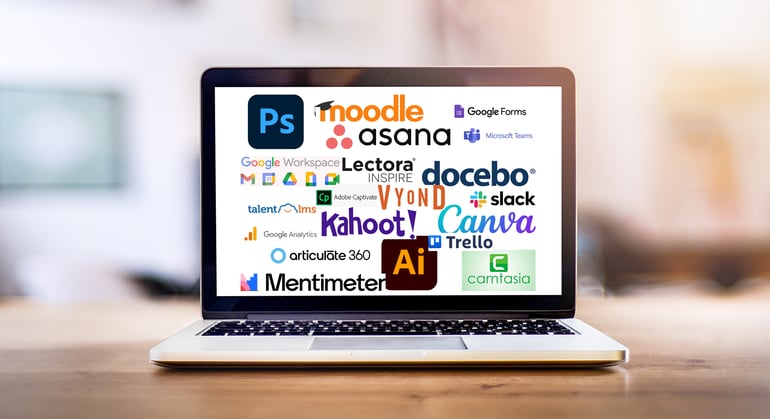
E-learning instructional design is a growing field that demands a diverse skill set, combining education, design, technology, and creativity.
As more organizations shift to online and blended learning, e-learning instructional designers are in high demand for their expertise in creating engaging and effective digital courses.
But what are the skills that make a great e-learning instructional designer?
This post will outline the top eight skills needed to excel in this field.
Let's get started!
1. Learning Theory and Instructional Design Principles

A strong foundation in learning theory and instructional design principles is crucial for creating effective e-learning experiences.
Instructional designers use models like ADDIE (Analyze, Design, Develop, Implement, Evaluate) and Bloom’s Taxonomy to develop learning objectives and ensure that content is structured in a way that maximizes retention.
Key Knowledge Areas:
- Understanding of how people learn and what keeps them engaged
- Familiarity with instructional design models (e.g., ADDIE, SAM)
- Ability to develop clear, measurable learning objectives
Why It Matters:
E-learning instructional designers need to apply theory to practice, ensuring that courses are not only engaging but also drive learning outcomes.
2. Proficiency with E-Learning Authoring Tools

Creating digital learning materials requires expertise in e-learning authoring tools like Articulate Storyline, Adobe Captivate, and Rise 360.
These tools allow instructional designers to build interactive, multimedia-rich courses that appeal to diverse learning styles.
Popular Tools to Learn:
- Articulate Storyline and Rise: Widely used for creating custom, interactive courses.
- Adobe Captivate: Known for software simulations and responsive design for mobile learning.
- Lectora Inspire: An accessible authoring tool that supports compliance with Section 508 and WCAG.
Why It Matters:
Mastering these tools is essential for creating high-quality e-learning experiences that incorporate video, interactive quizzes, and responsive design, allowing learners to engage with the content on any device.
Check out our post "What Software and Tools Should I Learn to Become an Instructional Designer?" for a deeper dive into the tools we'd recommend you learn.
3. Multimedia Design Skills

E-learning designers use visual and multimedia elements to keep learners engaged.
Knowledge of graphic design and video editing can be invaluable for creating visually appealing courses.
Proficiency in tools like Adobe Photoshop, Illustrator, Camtasia, and Vyond allows instructional designers to create custom graphics, infographics, and videos that elevate the learning experience.
Key Multimedia Tools:
- Adobe Photoshop and Illustrator: For creating graphics and custom illustrations.
- Camtasia: A video editing tool ideal for recording tutorials and software demonstrations.
- Vyond: A tool for creating animations and explainer videos without needing advanced animation skills.
Why It Matters:
Effective multimedia design enhances the learning experience by making complex concepts more digestible and visually engaging. This is especially important in e-learning, where learners may be more susceptible to distractions.
4. Knowledge of Learning Management Systems (LMS)

E-learning instructional designers need to understand Learning Management Systems (LMS) to deliver, track, and manage digital courses.
Familiarity with popular LMS platforms like Moodle, Canvas, and TalentLMS is often required, as these systems are used to organize course materials, track learner progress, and generate reports.
Popular LMS Platforms to Learn:
- Moodle: An open-source LMS widely used in education.
- Canvas: Known for its user-friendly interface and extensive integrations.
- TalentLMS: Popular in corporate training for managing employee onboarding and professional development.
Why It Matters:
An LMS is often the backbone of an e-learning program. Knowing how to upload content, track progress, and generate reports ensures instructional designers can effectively manage and measure the impact of their courses.
5. Project Management and Organizational Skills

Instructional designers often work on multiple projects simultaneously, requiring excellent project management skills to keep everything on track.
Whether you’re setting deadlines, coordinating with team members, or tracking milestones, strong project management skills help ensure that projects stay on time and within budget.
Popular Project Management Tools:
- Asana and Trello: For tracking tasks and project progress.
- Microsoft Teams and Slack: For team communication and collaboration.
- Google Workspace (Docs, Sheets, Slides): For collaborative document editing and file sharing.
Why It Matters:
E-learning projects often involve various stakeholders, including subject matter experts, graphic designers, and developers.
Effective project management helps instructional designers keep all parties aligned and ensures timely delivery of learning materials.
6. Data Analysis and Assessment Skills

Instructional designers must be able to evaluate the effectiveness of their courses.
By analyzing learner data and assessment results, they can refine content and improve learning outcomes.
Familiarity with data analysis tools and LMS reporting features is essential for gathering feedback, measuring knowledge retention, and identifying areas for improvement.
Key Data Analysis Tools:
- Google Analytics: For tracking user engagement and behavior on web-based courses.
- LMS Reporting Tools: Many LMS platforms have built-in reporting features for tracking learner progress and assessment scores.
- Google Forms and Microsoft Forms: Useful for collecting survey data and feedback from learners.
Why It Matters:
Data analysis allows instructional designers to assess whether learning objectives are met and to continuously improve their courses based on learner feedback.
7. Communication and Collaboration Skills

Instructional designers collaborate with subject matter experts, project managers, graphic designers, and other stakeholders.
Strong communication skills ensure smooth collaboration and help instructional designers incorporate feedback effectively.
IDs often need to explain technical concepts to non-technical team members and provide clear updates on project progress.
Collaboration Tools to Use:
- Microsoft Teams and Slack: For day-to-day communication and project updates.
- Zoom or Google Meet: For virtual meetings with stakeholders and team members.
- Google Workspace: Ideal for real-time collaboration on documents and presentations.
Why It Matters:
Clear communication and collaboration are essential for instructional designers who work with cross-functional teams. Good communication ensures projects move forward smoothly and that learning objectives align with stakeholder expectations.
8. Adaptability and Lifelong Learning

Instructional design is an ever-evolving field, especially with advancements in technology and digital learning.
The best instructional designers embrace change and actively seek to improve their skills.
Staying current with new authoring tools, e-learning trends, and learning theories enables IDs to create innovative and impactful learning experiences.
Ways to Stay Current:
- Professional Development Courses (such as Oregon State University’s E-Learning Instructional Design Certificate)
- Industry Blogs and Webinars (e.g., Learning Solutions, ATD webinars)
- Networking with Other IDs on platforms like LinkedIn or in professional organizations (e.g., Association for Talent Development)
Why It Matters:
The landscape of e-learning is constantly changing. Instructional designers who are adaptable and committed to continuous learning are better equipped to innovate and stay ahead of industry trends.
Conclusion: A Versatile Skill Set for a Rewarding Career
Instructional design is a multifaceted field requiring a blend of technical, creative, and analytical skills.
From understanding learning theory to using advanced e-learning authoring tools, the top skills listed here are essential for creating effective digital learning experiences.
E-learning instructional designers are shaping the future of education and training, making learning accessible, engaging, and impactful across industries.
If you’re interested in building these skills, consider enrolling in a program like the Instructional Design Certificate from Oregon State University.
With practical training in today’s essential tools and theories, you can develop the expertise needed to excel in this dynamic and rewarding field.
VIEW ALL THE POSTS IN THIS SERIES
 |
 |
 |
| The Importance of E-Learning in Today’s Workplace and Education | Instructional Design Careers 101: A Comprehensive Guide to This In-Demand Profession | What Industries Hire Instructional Designers? |








